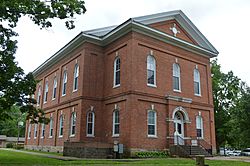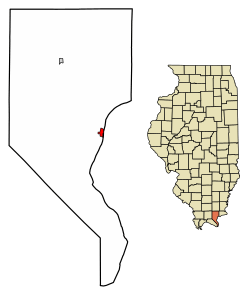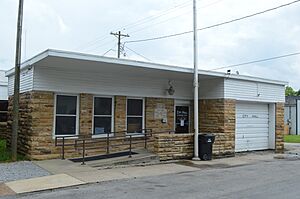Golconda, Illinois facts for kids
Quick facts for kids
Golconda, Illinois
|
|
|---|---|

Pope County Courthouse
|
|

Location of Golconda in Pope County, Illinois
|
|
| Country | United States |
| State | Illinois |
| County | Pope |
| Area | |
| • Total | 0.54 sq mi (1.41 km2) |
| • Land | 0.51 sq mi (1.32 km2) |
| • Water | 0.03 sq mi (0.09 km2) |
| Elevation | 430 ft (130 m) |
| Population
(2020)
|
|
| • Total | 630 |
| • Density | 1,235.29/sq mi (477.19/km2) |
| Time zone | UTC-6 (CST) |
| • Summer (DST) | UTC-5 (CDT) |
| ZIP Code(s) |
62938
|
| Area code(s) | 618 |
| FIPS code | 17-30133 |
| GNIS feature ID | 2394922 |
| Wikimedia Commons | Golconda, Illinois |
Golconda is a small city in Illinois, United States. It's the main town, or county seat, of Pope County. Golconda sits right by the Ohio River. In 2020, about 630 people lived there. Much of the city is part of the Golconda Historic District, which means it has many old and important buildings.
Contents
History of Golconda
The city of Golconda gets its name from an ancient city in India called Golkonda. This Indian city was famous for its strong fort.
Golconda, Illinois, was the first lasting settlement in Pope County. It was started in 1798. Around that time, a ferry service began crossing the Ohio River here. This ferry was sometimes called Lusk's Ferry.
When Pope County was officially formed in 1816, the town was first named Sarahsville. But on January 24, 1817, its name was changed to Golconda.
Many historic buildings were built in Golconda in the 1800s. The Buel House, a family home, was built in 1840. Today, the Illinois Historic Preservation Agency owns it. The First Presbyterian Church, built in 1869, is also very old. It is the oldest Presbyterian church group in Illinois that has been meeting continuously since it started in 1819.
The Trail of Tears Connection
Golconda played a part in a sad event called the "Trail of Tears". Around 13,000 Cherokee people, led by Chief Bear Paw, crossed the Ohio River at Golconda by ferry. They were being forced to move from their homes to Oklahoma.
To prevent the spread of sickness, the Native Americans were not allowed to enter any towns or villages. This often meant they had to travel much farther to go around them. After traveling through Tennessee and Kentucky, they reached the Ohio River across from Golconda around December 3, 1838.
The Cherokee people were very hungry. They were charged one dollar per person to cross the river on "Carpenter's Ferry". This was much more than the usual twelve cents. They had to wait to cross until the ferry had served everyone else. Many died while waiting under a bluff called "Mantle Rock" on the Kentucky side. Some Cherokee people also faced harm from locals. However, the Carpenter family, who helped found Golconda, rescued and sheltered many of them.
Geography of the City
Golconda covers a total area of about 0.503 square miles (1.30 square kilometers). Most of this area, about 0.49 square miles (1.27 square kilometers), is land. A small part, about 0.013 square miles (0.034 square kilometers), is water.
Population and People
| Historical population | |||
|---|---|---|---|
| Census | Pop. | %± | |
| 1860 | 404 | — | |
| 1870 | 858 | 112.4% | |
| 1880 | 1,000 | 16.6% | |
| 1890 | 1,174 | 17.4% | |
| 1900 | 1,140 | −2.9% | |
| 1910 | 1,088 | −4.6% | |
| 1920 | 1,242 | 14.2% | |
| 1930 | 1,184 | −4.7% | |
| 1940 | 1,301 | 9.9% | |
| 1950 | 1,066 | −18.1% | |
| 1960 | 864 | −18.9% | |
| 1970 | 922 | 6.7% | |
| 1980 | 960 | 4.1% | |
| 1990 | 823 | −14.3% | |
| 2000 | 726 | −11.8% | |
| 2010 | 668 | −8.0% | |
| 2020 | 630 | −5.7% | |
| U.S. Decennial Census | |||
In 2000, there were 726 people living in Golconda. These people lived in 330 households, and 163 of these were families. The city had about 1,287 people per square mile (497 people per square kilometer).
Most people in Golconda were White (95.45%). There were also small numbers of African American, Native American, and Asian residents. About 0.41% of the population were Hispanic or Latino.
About 22.4% of households had children under 18 living with them. The average household had about 1.98 people, and the average family had about 2.86 people.
The population's age was spread out. About 20.4% were under 18 years old, and 29.1% were 65 years or older. The average age in the city was 45 years.
Famous People from Golconda
Several notable people have connections to Golconda:
- James Lusk Alcorn (1816–1894): He was a senator and the 28th governor of Mississippi.
- John R. Hodge (1893–1963): A military general who was the military governor of South Korea.
- Mason Ramsey (born 2006): Known as the "Walmart Kid Singing," he became famous from a viral video and is now a country singer.
- Green B. Raum (1829–1909): A Union general during the Civil War, a congressman, and head of the Internal Revenue Service.
- James A. Rose (1850–1912): He served as the Illinois Secretary of State.
Golconda in Books and Movies
Golconda has been mentioned in books and movies.
- In the 1991 book "Walking the Trail" by Jerry Ellis, the author writes about his visit to Golconda. He was walking 900 miles to retrace the Trail of Tears in reverse.
- In the movie "U.S. Marshals," actor Tommy Lee Jones mentions Golconda. He tells law enforcement where to set up roadblocks along the Ohio River.
Images for kids
See also
 In Spanish: Golconda (Illinois) para niños
In Spanish: Golconda (Illinois) para niños



